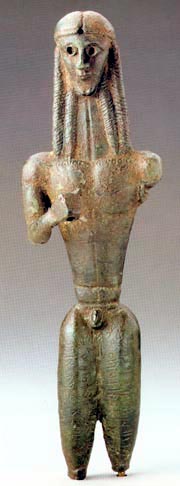The Orientalizing Period
c. 700-600 BCE
ORIENTALIZING SCULPTURE
In 7th century the first relatively large stone sculptures appear, probably under the influence of Egypt. The early style has been called DAEDALIC (after the legendary Cretan craftsman). Daedalic is an Orientalizing style, and was invented on Crete before the middle of the 7th century.
Almost all the figures are draped women or youths, often wearing broad belts. The musculatire of the youths is schematized. Both male and female figures are conceived frontally (meant to be seen from the front) with their bodies rendered flat and plank-like. A flat head with a low forehead and large eyes set in a triangular face are characteristic. The hair of both sexes appears wig-like.
In contrast to the Geometric, bodies are less angular and more rounded.

The Mantiklos Bronze
from Thebes
c. 700-675 BCE
Bronze (solid)
Height: 74/5 inches
(Museum of Fine Arts, Boston)
The triangular chest and the geometric rigidity of the figure is softened by the roundness given to the shoulders, chest, thighs, and buttocks. This increased appearance of natural corporeality in the body is negated however by the stiffening, formalizing effect of the triangular face, the large eyes, the heavy strands of hair, and the belt.
The inscription on the legs reads:
"Mantiklos dedicated me as his tithe to the far-striking god with the silver bow. Do thou, O Phoebus, grant him his desired reward."

The "Lady of Auxerre"
c. 640 BCE
Limestone
Height: 251/2 inches
(Musée du Louvre, Paris)
This example of the Daedalic style in sculpture shows a female figure wearing a long skirt with a wide belt, simple top, and some kind of short attached cape or shawl. The skirt has incised decorations (once brightly painted). The figure is severely frontal with the feet close together. The long-fingered right hand is held in front of the breasts. The left arm is placed stiffly down the side. The body is indicated under the drapery, with her figure, especially her waist and breasts, emphasized by the tight belt. The head most characteristic of Daedalic style with its triangular face, low forehead, large eyes, the top of head flat, and heavy, braided, wig-like hair.
The "Lady of Auxerre" is named after the little Museum of Auxerre, a small city in the vicinity of Paris, where, in 1909, a curator from the Louvre noticed the statue in the museum's storage vault.

Kneeling Youth
c. 625 BCE
from Samos
Ivory
Height: 53/4 inches
(Archaeological Museum, Samos)
This ivory figure clearly formed part of a larger object, possibly the arm of a lyre. The craft of ivory carving re-appears in Greece in the 8th century BCE and follows closely Near Eastern types and styles. The inlay details - eyes, eyebrows, locks of hair on brow, ears, pubic hair - were presumably of different colored materials (remains of amber have been preserved in the locks of the hair on the brow). The carving of the musculature is especially refined in the area of the chest (the pectoral muscles and clavicles) and the stomach. However, the figure retains the triangular torso, long, sausage-like legs of the Daedalic style.

|
© Christopher L. C. E. Witcombe
|

 SPRING 2016
SPRING 2016  SCHEDULE
SCHEDULE  REQUIREMENTS
REQUIREMENTS

 SPRING 2016
SPRING 2016  SCHEDULE
SCHEDULE  REQUIREMENTS
REQUIREMENTS